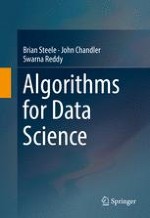2016 | OriginalPaper | Buchkapitel
9. k-Nearest Neighbor Prediction Functions
verfasst von : Brian Steele, John Chandler, Swarna Reddy
Erschienen in: Algorithms for Data Science
Aktivieren Sie unsere intelligente Suche, um passende Fachinhalte oder Patente zu finden.
Wählen Sie Textabschnitte aus um mit Künstlicher Intelligenz passenden Patente zu finden. powered by
Markieren Sie Textabschnitte, um KI-gestützt weitere passende Inhalte zu finden. powered by
